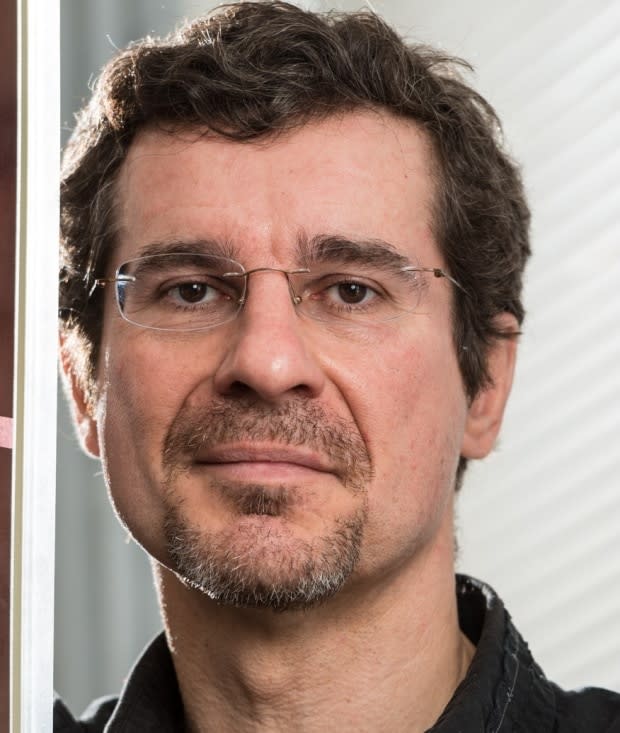UNB professor working on a mask that would kill the coronavirus

Amid growing evidence of airborne transmission of COVID-19, the work of one New Brunswick researcher could become an important tool to help prevent the spread of the virus.
Felipe Chibante, a professor of chemical engineering at the University of New Brunswick, is working on a face mask that would not only trap the coronavirus, it would kill it.
He says that same technology could eventually lead to air filters that would do the same thing on a larger scale for homes and office buildings.
The key is to use tiny particles of virus-killing material to make the masks.
Incorporating such metals into a face mask "at the nano-scale is very effective at killing airborne pathogens," he said.
Chibante is one of several New Brunswick researchers to receive money for COVID-19-related projects.

In March, the New Brunswick Innovation Foundation, in partnership with the New Brunswick Health Research Foundation (NBHRF), launched a COVID-19 Research Fund and invited researchers to apply — which they did in droves.
They received 60 applications and requests for $2.3 million in funding, which was more money than they had available.
That's when the Atlantic Canada Opportunities Agency (ACOA) stepped in to provide more funding. In total, 27 projects across the province have been approved — to the tune of $846,707.
As people and governments debate whether to make face masks mandatory, a growing body of scientific and anecdotal evidence suggests airborne transmission may be important in spreading the virus.
In an open letter published earlier this month, 239 scientists from 32 countries called on the World Health Organization to acknowledge that airborne transmission of the coronavirus is a potential driver of the pandemic.
The WHO had long maintained that the virus is spread by large droplets, but recently acknowledged the possibility of airborne transmission, saying it cannot be ruled out.
Those developments aren't lost on Chibante, who says airborne transmission makes the use of masks even more important.
Chibante, whose background includes working with nano-particles in the development of clean energy, says the first step in the project is to create nano-coatings capable of killing airborne pathogens, like the virus that causes COVID-19.

That material would then be incorporated into the mask itself and help filter out particles.
Chibante and his team will be working with several metals that have already proven their antibacterial and antiviral properties. Copper for example, has long been known to disrupt or kill pathogens, which include bacteria, viruses, or other microorganisms that can cause disease.
Silver is another possibility, although only when reduced to nano-size. Chibante explained that the properties of some metals, like silver, change when reduced and they become "the enemy of viruses."
Teaming up with Sabian
Chibante's team will be working with the Sabian cymbal company of Meductic, which will provide some of the metal material that his team will "nano-ize" for the project.
Sabian offered to supply the raw material for the project, explained chief operating officer Mike Connell.
In fact, the company approached the New Brunswick Innovation Foundation early on in the pandemic to explore ways it could help in the global fight against COVID-19.
After all, company officials were already aware of the antiviral potential of copper, said Connell.

They had a lot of copper sitting around and business had dropped off as a result of the pandemic, he said.
"We thought there might be potential … for high touch-point items made of copper alloys because of its disinfectant properties."
Connell said they wondered about whether copper could be incorporated into face masks. They were just tossing around ideas at the time, and he said they're pleased to leave the scientific part of the project to the experts.
He said they initially handed over a supply of the exact same material used for making cymbals — a combination of copper and tin — and will create different combinations of metals if asked to do so as the project progresses.
Once an effective coating is developed, it will be incorporated into the mask itself. That way, when viruses are trapped in the mask's filtration system, it doesn't continue to live there.
"We know that COVID can hang around for a long time," he explained. "So now you have a mask that's a biohazard, and you have to dispose of it, and there's hundreds of millions of masks in Canada that we're processing as biohazard. And so the idea was, can we do something that would actually kill the virus once it landed on the mask?"

Chibante said being able to destroy the virus eliminates the argument some people have made about masks being harmful to the wearer. A COVID-killing mask will not only protect other people, but will protect the person wearing it, he said.
"So it's community hygiene as opposed to individual hygiene," said Chibante.
Eventually, he hopes to eliminate another complaint of mask-haters by making them see-through to allow for better communication.
As an added phase to the project, he's using his work in the energy sector to create a self-sanitizing feature for the masks. Since pathogens can usually be destroyed at temperatures above 60 Celsius, he envisions using tiny electrical systems to create enough heat in the mask to destroy anything that wasn't already killed on contact with the anti-viral coating. He says it could be as easy as plugging the mask into a USB port to activate what could be thought of as "nano-zappers."
"By engineering and controlling those electrical properties, we can actually be able to heat up the mask internally where all the action is. We don't want to just blow hot air into it. We want to have it, you know, almost like a little toaster element inside your mask."
Chibante says the technology could eventually be expanded for use in air-exchange systems in homes and commercial buildings.
"It's the same kind of principle where you have an airborne pathogen and you want to remove it, and you don't want to be just changing your filters every day. You want to reuse that filter for a period of time. So we see this being able to extend beyond just personal protection equipment but to, you know, commercial systems."


